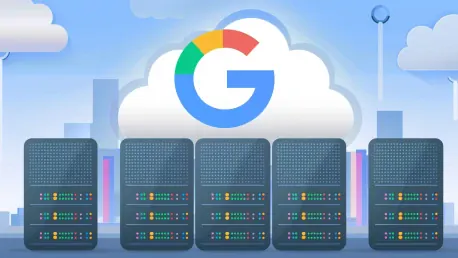The race to harness the transformative power of AI in enterprise applications continues to accelerate, and Google Cloud steps up the game with its latest data cloud innovations. At the heart of these developments is Spanner Graph, a cutting-edge feature integrating graph database functionalities with Google’s globally scalable and consistent Spanner database. This fusion is set to revolutionize how businesses manage and analyze interconnected data, propelling them towards more sophisticated and intelligent AI applications.
Uniting Spanner Capabilities with Graph Database
Spanner Graph Overview
Spanner Graph represents a significant leap in Google Cloud’s mission to offer robust data cloud services. By merging graph database capabilities with Spanner’s stellar scalability and consistent performance, this innovation allows businesses to manage intricate, interconnected data seamlessly. This approach aims to elevate data relationships and contextual insights, crucial for advanced AI applications. The seamless blend of these two powerful technologies puts Spanner Graph at the forefront of advancements that transform data handling, giving enterprises the tools to extract deeper insights from their digital assets.The innovative aspects of Spanner Graph don’t stop at mere integration; the platform is designed to handle transparent sharding and elastic scaling capabilities required for managing massive datasets. Utilizing massively parallel query processing, Spanner Graph offers high performance without the need for constant user intervention. This ensures that businesses can efficiently scale their operations while maintaining optimal performance. The deep integration with Vertex AI, Google’s unified AI development platform, allows users to generate text embeddings for nodes and edges, and employ vector search for semantic data retrieval, making Spanner Graph an instrumental tool in powering next-gen AI applications.
Key Functionalities
Spanner Graph comes loaded with features like transparent sharding and elastic scalability to handle massive datasets. Its massively parallel query processing guarantees high performance without user hassle. Additionally, it’s tightly integrated with Vertex AI, Google’s unified AI development platform, enabling users to generate text embeddings for nodes and edges and perform semantic data retrieval through vector search, all within Spanner Graph’s framework. This makes the platform exceptionally well-suited for complex AI-driven tasks that require both relational and graph data insights.By leveraging the power of large language models (LLMs) for text embeddings, Spanner Graph facilitates more nuanced and relevant data analyses. Vector search capabilities further allow for highly accurate and fast retrieval of semantic information, making it an efficient tool for numerous high-stakes applications. For example, in scenarios involving massive volumes of interconnected data, such as social networks or financial transactions, the ability to seamlessly process and analyze this data in real time is invaluable. This technology can transform the way businesses interact with their data, offering unparalleled accuracy and depth of insight.
Real-world Applications
Spanner Graph shines in real-world scenarios such as product recommendations, where it models complex relationships to offer context-rich insights combining rapid graph traversal and full-text search based on user queries and preferences. This capability ensures that recommendations are not just timely but also highly relevant, improving user engagement and satisfaction. In the realm of financial fraud detection, Spanner Graph’s ability to map intricate connections between financial entities assists in the swift identification of anomalies and potential threats, thereby mitigating risks swiftly and effectively.Another critical application lies in the domain of social networks, where Spanner Graph models social interactions and relationships. This facilitates the discovery of patterns for personalized recommendations and allows natural language queries via integrated full-text search to find people, groups, posts, or topics efficiently. In the gaming industry, Spanner Graph’s ability to represent game worlds through entities like players, characters, items, and locations helps to manage essential game mechanics like pathfinding and inventory management. The scalability and global consistency ensure that players experience seamless gameplay, even during peak times, further enhancing user engagement.
Accelerating AI in BigQuery and Looker
The Gemini Enhancements
Google Cloud’s AI capabilities are not restricted to Spanner Graph alone. The introduction of Gemini features across their platforms, including BigQuery and Looker, aims to streamline the transition from data to AI using multimodal, multi-engine, and multicloud technologies. Gemini’s innovations in BigQuery enhance data preparation, exploration, and analysis while maintaining security and governance. These enhancements underline Google Cloud’s commitment to making AI more accessible and actionable for enterprises, paving the way for smarter, data-driven decision-making.Gemini in BigQuery, now generally available, significantly amplifies AI-powered features such as code assistance for SQL and Python, which tremendously boosts productivity and accuracy in coding. BigQuery’s Data Canvas stands out as another notable addition, offering a user-friendly visual interface for data visualization and manipulation. This tool empowers users to navigate complex data analysis processes seamlessly, helping them derive actionable insights more efficiently. These features collectively aim to empower users by making advanced analytical capabilities more accessible, thus driving better outcomes in a faster and more efficient manner.
BigQuery Advancements
Gemini in BigQuery, now generally available, boasts AI-powered features such as code assistance for SQL and Python, significantly boosting productivity and accuracy in coding. The Data Canvas is another notable addition, offering a visual interface for data visualization and manipulation, assisting users in navigating complex data analysis processes seamlessly. By enabling users to interact with their data more intuitively, these enhancements lower the technical barriers often associated with advanced data analysis, thereby democratizing access to powerful analytical tools.Additionally, Gemini provides intelligent partitioning and clustering recommendations, optimizing data storage and retrieval efficiency. These suggestions assist users in structuring their datasets in a way that maximizes performance and minimizes costs. By integrating these AI-driven features, BigQuery aims to streamline the data analysis process, making it more efficient and user-friendly. The combined functionalities empower users to extract maximum value from their data, propelling them towards more informed decision-making and strategic planning.
Looker Upgrades
Looker, enhanced with Gemini features, now previews formula assistance and automatic slide generation, allowing users to interact more intuitively with their data. These upgrades facilitate the creation of calculated fields without extensive formula knowledge and generate insightful presentation-ready slides, enhancing the efficiency and effectiveness of data-driven decision-making. Users can now create rich, data-driven reports more easily, making it simpler to convey key insights to stakeholders and support strategic initiatives.The Gemini enhancements in Looker also include intelligent recommendations for data visualization, helping users choose the most effective ways to present their data. These capabilities ensure that the insights gleaned from data analysis are not only accurate but also effectively communicated, driving better decision-making across the organization. The inclusion of AI-driven features in Looker highlights Google Cloud’s commitment to empowering users with tools that make complex data analysis and reporting more accessible and impactful, transforming how businesses interact with their data.
Enhancements for Unified AI Ecosystem
Comprehensive AI Strategies
Google Cloud’s enhancements are designed not just for specific tools but to cultivate a unified AI development ecosystem. By integrating advanced AI functionalities across platforms, Google Cloud is streamlining workflows and boosting productivity through seamless interactions between tools like Spanner Graph, BigQuery, and Looker, thereby fostering a robust, intelligent data management environment. This integrated approach ensures that users can leverage the full potential of AI capabilities without having to navigate disparate systems, leading to a more cohesive and efficient data strategy.The strategic integration of these tools underscores Google Cloud’s vision of creating a synergistic ecosystem where data and AI coexist seamlessly. This ecosystem approach empowers users to derive richer insights and more actionable intelligence from their data, ultimately enhancing decision-making processes within enterprises. The unified AI capabilities ensure that the data journey from ingestion to analysis and application is smooth, efficient, and highly productive, setting a new standard in enterprise data management and AI development.
Spanner Editions and Flexible Pricing
Accommodating diverse user needs, Google Cloud introduces varied Spanner editions—Standard, Enterprise, and Enterprise Plus. This new pricing strategy includes per server billing and separates compute from network replication expenses, making it more transparent and adaptable to different business scales and requirements. By offering a tiered pricing model, Google Cloud ensures that businesses of all sizes can access the powerful capabilities of Spanner Graph without being constrained by budget limitations.The introduction of Spanner editions also allows businesses to scale their operations more predictably and cost-effectively. Companies can choose the edition that best fits their operational requirements and budget constraints, ensuring that they only pay for the resources they actually use. This flexible pricing model aims to democratize access to high-end data and AI capabilities, enabling a broader range of enterprises to benefit from the advanced functionalities of Spanner Graph and related tools.
Geo-Partitioning and Dual-Region Configurations
The race to harness AI’s transformative power in enterprise applications is accelerating, and Google Cloud is raising the stakes with its latest data cloud innovations. A standout feature in these new advancements is Spanner Graph, which integrates the sophisticated graph database functionalities with Google’s highly scalable and globally consistent Spanner database. This groundbreaking blend is poised to revolutionize how enterprises manage, analyze, and utilize interconnected data, driving them toward more sophisticated and intelligent AI applications.As companies increasingly seek to leverage AI for more complex tasks, the ability to effectively manage large sets of interrelated data is crucial. Spanner Graph aims to simplify this challenge by providing a single, powerful platform for storing and querying vast amounts of linked data. This not only enhances data integrity and accessibility but also paves the way for innovative AI solutions across industries. By enabling businesses to glean deeper insights from their data, Google Cloud’s novel offering could play a pivotal role in shaping the future of enterprise AI, making it more intuitive and impactful than ever before.









